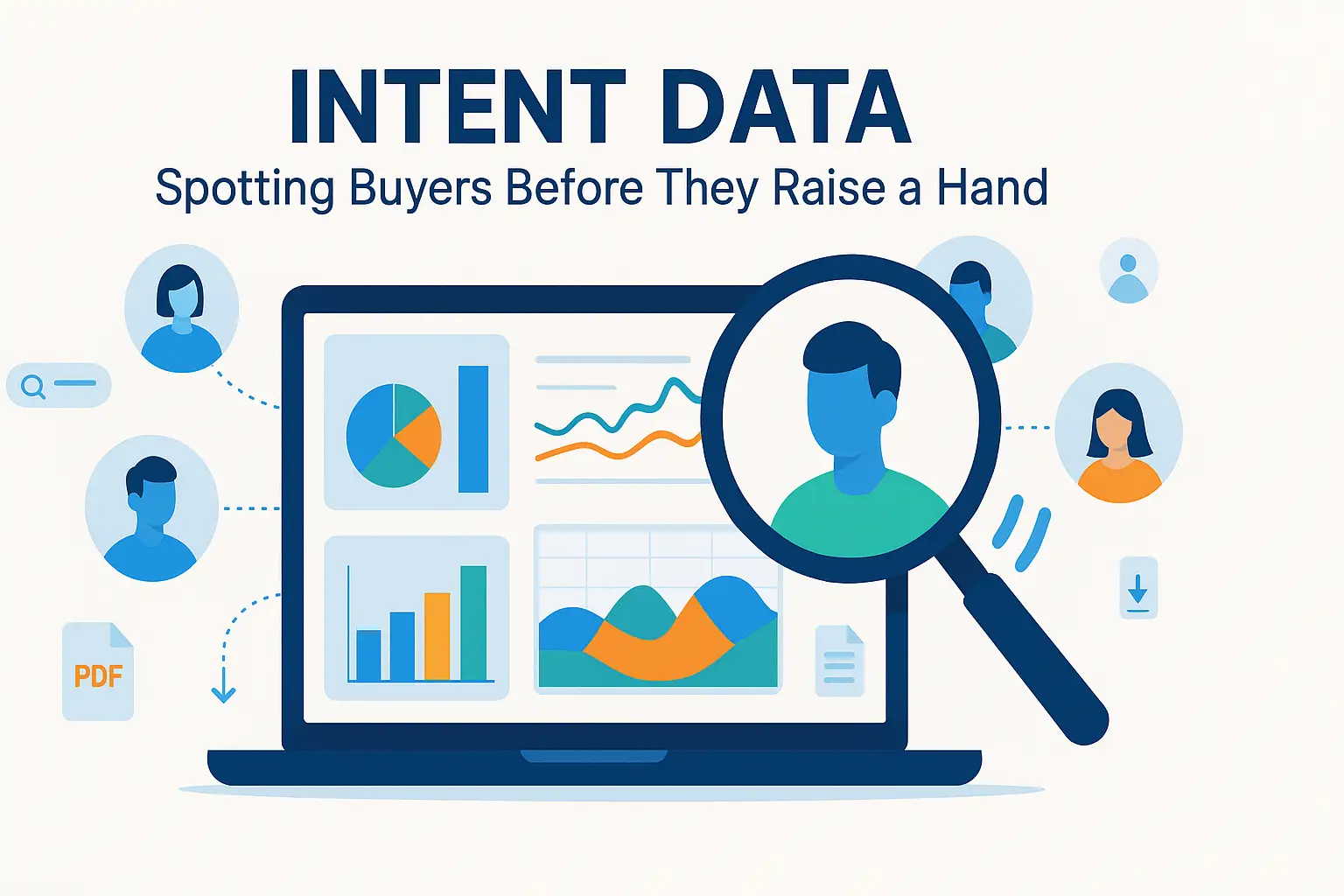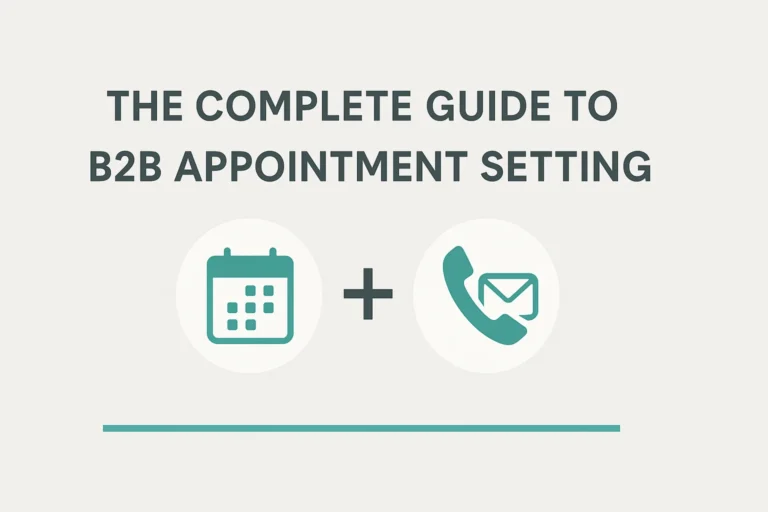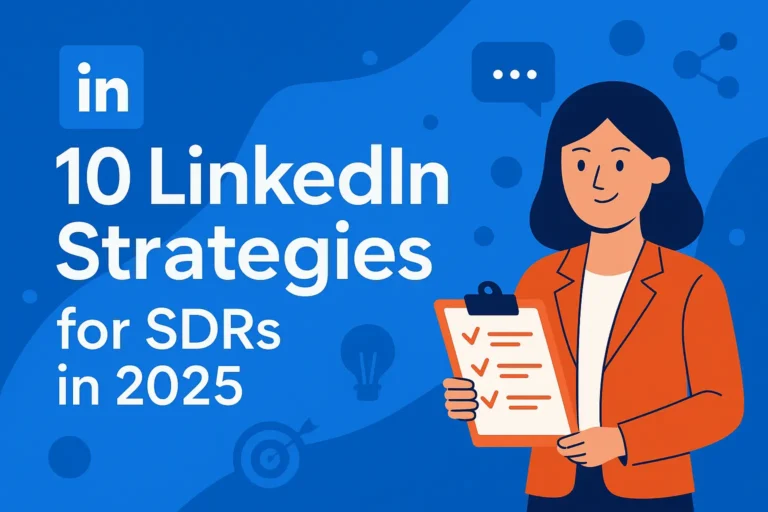Intent Data: Spotting Buyers Before They Raise a Hand
1. What exactly is “intent data”?
Every online action leaves a breadcrumb—searches, reviews read, white-papers downloaded. When several breadcrumbs point to the same topic at the same time, they reveal intent: a signal that someone is researching a solution and might soon buy.
There are three common sources:
| Source | Where it lives | Example signals |
| First-party | Your own site and emails | Repeat visits to a pricing page, high scroll depth on a use-case article |
| Co-op / second-party | Data-sharing networks | Anonymous users reading comparisons on a review platform |
| Third-party | External publishers & ad exchanges | Surge in downloads of an industry report across dozens of domains |
Because third-party lists pool many websites, they can warn you weeks before a prospect ever clicks an ad or fills a form.
2. Why it matters in 2025
- 57 % of B2B teams say intent data lifts lead-to-deal conversions by ≥ 40 %
- Brands using intent signals cut cold-call volume 28 % while keeping meeting totals flat—time that reps now spend on warmer prospects.
- Nearly half of companies (49 %) name intent data their #1 tactic for improving lead quality.
In short: fewer dials, more relevance, bigger pipeline.
3. Where to find usable signals
- Review sites – Tools like G2 or TrustRadius flag spikes in product-category interest.
- Topic networks – Providers such as 6sense or Bombora monitor thousands of publisher pages for keyword surges. Reviews cite their strength in ranking accounts by research depth.
- Hiring feeds – Job ads hint at new projects (e.g., “looking for CRM admin” signals a platform change).
- Technographic scanners – Browser plug-ins show which tools a site just installed or dropped.
- First-party behaviour – Repeat traffic to a calculator or demo page on your site.
Tip: pick one paid source, one free (Google Analytics), and combine them—you don’t need a dozen dashboards.
4. Scoring intent without a data-science degree
- List 5–7 “buying triggers” (e.g., reads three cybersecurity articles, views two pricing pages).
- Give each trigger a weight from 1–10 based on past deals.
- Sum weights over a 14-day window for every account.
- Flag anything above your historical close-won median as “hot”.
Even a basic spreadsheet beats gut feeling. Refresh weights quarterly as markets shift.
5. Five-step playbook for appointment setting
| Step | Action | Why it works |
| 1. Align on triggers | Sales, marketing, and ops agree on the weighted list. | Prevents “false positives” that waste rep time. |
| 2. Update your CRM nightly | Feed fresh intent scores into a single field. | Reps wake up to ranked call lists—no manual sorting. |
| 3. Respond fast | Call or email within 24 h of a score crossing the “hot” line. | Timely outreach can double reply rates. |
| 4. Lead with context | Open with why you reached out: “Noticed you’re researching multi-factor login…” | Shows you listened, not spammed. |
| 5. Track three numbers weekly | Contact-to-meeting %, Show-rate %, Cost-per-meeting. | Tight feedback loops tune the system quickly. |
6. Real-world benchmarks to aim for
| Metric | Median with intent data | Median without |
| Contact-to-meeting | 12–15 % | 5–7 % |
| Meeting show-rate | 65 % | 50 % |
| Cold call volume / rep / day | 35-40 | 55-60 |
Pull your own baselines first; then chase the gap gradually.
7. Common pitfalls—and fixes
| Pitfall | How to avoid it |
| Data overload | Start with two data sources; add more only if accuracy plateaus. |
| Dirty contact info | Validate emails and phone numbers weekly; bad data kills sender reputation. |
| Privacy mis-steps | Map every signal to a legal basis (consent, legitimate interest). EU GDPR, California’s CCPA, and India’s new DPDPA all expect evidence on request. |
| Generic outreach | Personalise the first 50 words; reference the researched topic or event. |
8. Budget-friendly tool stack (under $500/month)
| Need | Lean option | Notes |
| Account-level intent | Bombora Starter surge reports | Free tier for limited keywords. |
| Contact data & light intent | ZoomInfo “Starter” or UpLead | Users praise ease of export. |
| Email verification | NeverBounce pay-as-you-go | Keeps bounce rate <5 %. |
| CRM sync | Native integrations or low-code tools like Zapier | Automates nightly score updates. |
Start lean; upgrade only when ROI is proven.
9. Compliance checklist for 2025
- Consent logs – Keep time-stamped proof for every email address you upload.
- Opt-out respect – Automate suppression lists across all tools.
- Data-transfer rules – If signals cross borders, follow EU-U.S. DPF or APAC CBPR guidance.
- Security audits – Demand ISO-27001 or SOC 2 from providers; review reports yearly.
Regulators raised fines in multiple regions last year—prevention beats penalties.
10. Quick start—your first 30 days
| Week | Focus | Output |
| 1 | Define triggers & weights | One-page intent matrix |
| 2 | Connect data to CRM | Auto-updated score field |
| 3 | Train reps on “context first” outreach | Call and email templates |
| 4 | Launch pilot on 200 accounts | Review metrics; adjust weights |
If meetings grow and cost per meeting drops, roll the system to all segments next quarter.
Final takeaway
Intent data turns hidden online research into a flashing buying now sign. Used well, it lets your team call the right buyers days—sometimes weeks—before competitors even know a project exists. Start small, score signals, act fast, and measure hard results. The outcome is a calmer rep calendar, warmer conversations, and a pipeline that fills itself long before quarter-end.







